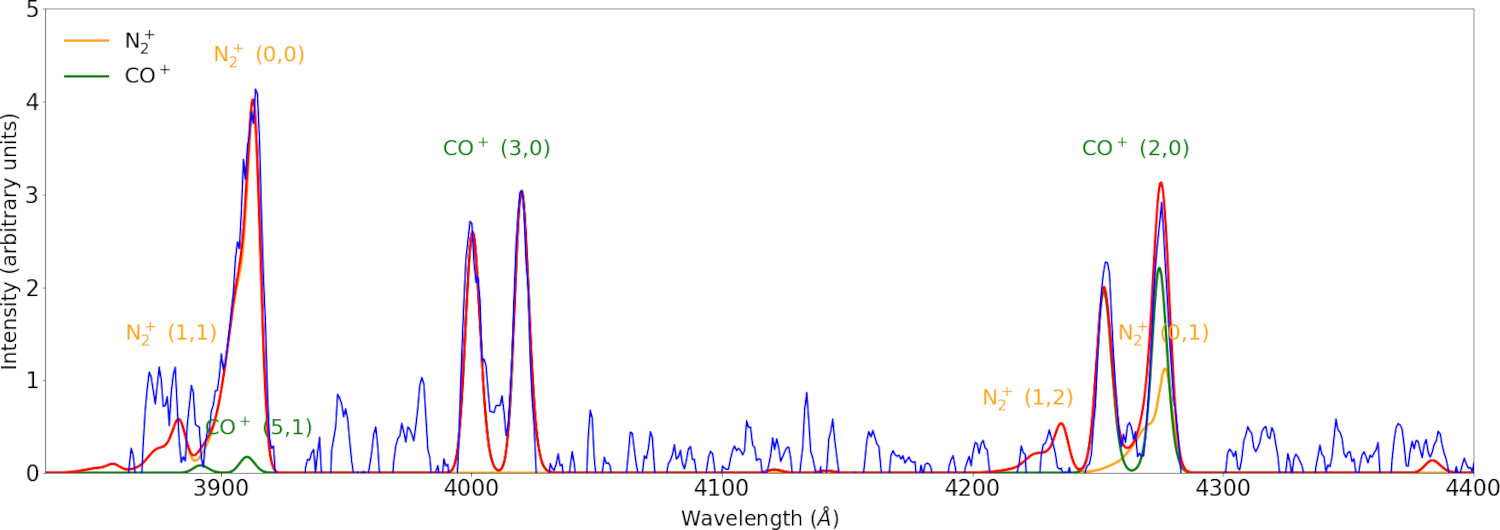A reanalysis of the N2+/CO+ ratio in comet C/2002 VQ94
- 1Institut UTINAM - UMR 6213, CNRS / Université de Franche-Comté, OSU THETA, 41 bis Av. de l’Observatoire, BP 1615, F-25010 Besançon Cedex, France (phil@obs-besancon.fr)
- 2Main Astronomical Observatory of the National Academy of Sciences of Ukraine, 27, Akademika Zabolotnoho Str., Kyiv, 03143 Ukraine
- 3Astronomical Institute of the Slovak Academy of Sciences,Tatranská Lomnica, SK-05960 Slovak Republic
1. Introduction
C/2002 VQ94 (LINEAR) is a long period comet that passed its perihelion on February 7, 2006 at a distance of 6.8 au from the sun. Over an extended period of time the comet had an asteroidal appearance without any sign of cometary activity. Such an activity was first detected before its perihelion passage at the end of August 2003, when it was at a distance of 8.9 au from the Sun. Spectroscopic observations were conducted on March 2006 shortly after perihelion passage. These observations lead to the surprising discovery of N2+ emission lines (Korsun et al., 2006). CO+ and N2+ were confidently measured in 2007 during some other observations (Korsun et al., 2008). Two other observing runs were conducted in March 2008 and March 2009. The observations conducted in March 2008, at 8.36 au from the Sun also revealed N2+ emission lines, however no emissions were found in the spectrum obtained at 9.86 au in 2009. A N2+/CO+ ratio was estimated to be 0.06 (Korsun et al, 2014) based on fluorescence efficiencies published by Lutz et al. (1993) for N2+ and Magnani & A’Hearn (1986) for CO+. Because new fluorescence models have now been published for these two species we reanalyze these data to get updated N2+/CO+ ratio for this comet.
2. Observations
Observations were carried out with the 6-m Big Telescope Alt-azimuth (BTA) operated by SAO in March 2008. A focal reducer SCORPIO attached to the prime focus of the BTA telescope was used with the transparent grisms VPHG1200B as disperser in the spectroscopic mode and a long-slit mask with 6.10’x1.0’’ dimensions was projected on the cometary coma. The spectral resolution of the spectra was about 6 Å. Three different spectra of 1200 s of integration time each were obtained on March 13, 2008, with a spectral range of 3600-5400 Å. These three spectra were combined in a first step by median filtering between the frames and in a second step in a 1D spectrum computed by collapsing the 2D median spectrum in the spatial direction where a coma was detected. The solar continuum was subtracted to the 1D spectrum, based on a theoretical solar spectrum convolved with a similar instrument response function and adjusted to the cometary spectrum.
3. Modeling
We used the two fluorescence models developed for both N2+ (Rousselot et al., 2022) and CO+ (Rousselot et al., 2024) to model high-resolution spectra obtained on the comet C/2016 R2 (PanSTARRS). This comet having unusual bright emission lines of N2+ and CO+ (Opitom et al., 2019) constituted an ideal target for testing these fluorescence models. After different tests we managed to get a satisfatory fit of the average 1D spectrum published in Korsun et al. (2014) by using N2+/CO+ ratio of 0.08. Such a ratio is a little bit higher than the first estimate published in this article. Fig. 1 presents this fit.

Figure 1: Comparison of the spectrum of comet C/2002 VQ94 (blue) observed at 8.36 au with our modeling of N2+ and CO+. The sum of the N2+ and CO+ emission bands appear in red. Some other faint possible emission lines (e.g. CN band near 388 nm) have not been taken into account in this modeling, the brightest bands of interest being not blended by these possible emission bands.
4. Conclusion
Our reanalysis confirms the order of magnitude of the previously estimated N2+/CO+ ratio, which appear a little bit greater than this initial estimate. It also confirms that C/2002 VQ94 belongs to the very few comets having a significant fraction of N2+ (and consequently N2) in their coma, this species being usually not detected in the cometary coma. Comets identified so far with a similar N2+/CO+ fraction are C/1908 (Morehouse), C/1940 N2 (Cunningham), C/1947 S1 (Brester), C/1956 (Arend-Roland), C/1969 Y1 (Bennett), C/1973 R1 (Kohoutek), C/1986 P1 (Wilson), C/1987 P1 (Bradfield) and C/2016 R1 (PanSTARRS) (see, e.g. Anderson et al., 2023 for more details).
The case of the observations reanalyzed in this work is also unique for the record heliocentric distance at which this species, as well as CO+ was identified (8.36 au). Such large heliocentric distance was also a good test for the new CO+ and N2+ models developped for computing cometary fluorescence spectrum
References
- Anderson S. et al., 2023, MNRAS 524, 5182-5195
- Korsun P., et al., 2006, A&A 459, 977-980
- Korsun P., et al., 2008, Icarus 198, 465-471
- Korsun P., et al., 2014, Icarus Icarus 232, 88–96
- Lutz B.L., et al., 1993, Ap.J. 407, 402-411
- Magnani L., A’Hearn M.F, 1986, Ap.J. 302, 477-487
- Opitom C., et al. 2019, A&A, 624, A64
- Rousselot P., et al., 2022, A&A 661, id. A131
- Rousselot P., et al., 2024, A&A 683, id. A50
How to cite: Rousselot, P., Kulyk, I., and Ivanova, O.: A reanalysis of the N2+/CO+ ratio in comet C/2002 VQ94, Europlanet Science Congress 2024, Berlin, Germany, 8–13 Sep 2024, EPSC2024-251, https://doi.org/10.5194/epsc2024-251, 2024.